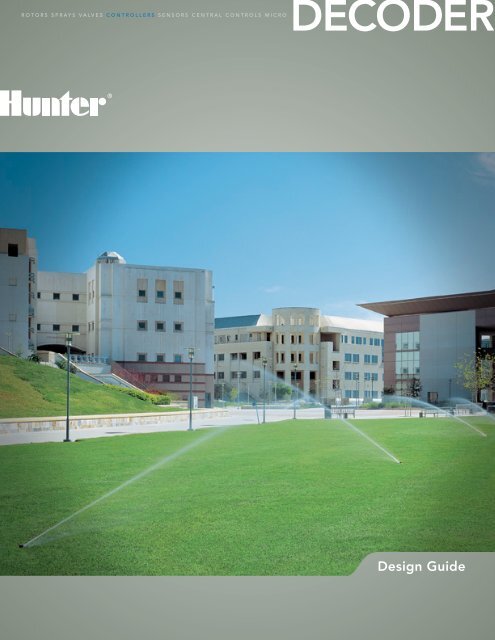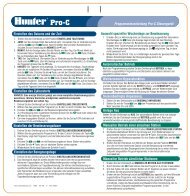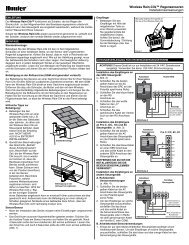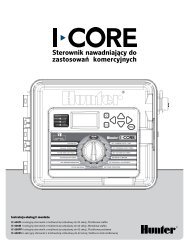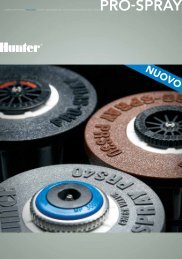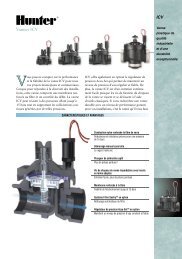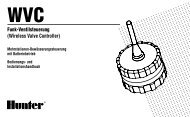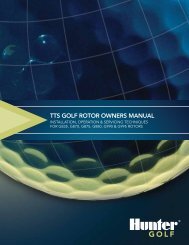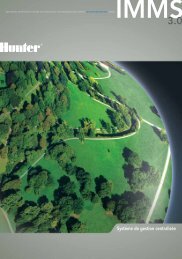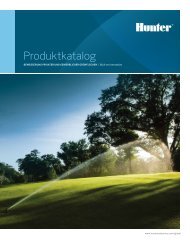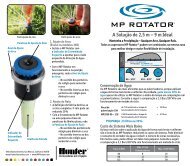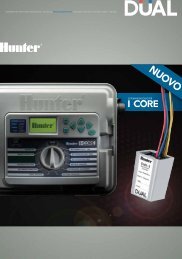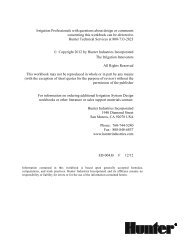Decoder Design Guide - Hunter Industries
Decoder Design Guide - Hunter Industries
Decoder Design Guide - Hunter Industries
Create successful ePaper yourself
Turn your PDF publications into a flip-book with our unique Google optimized e-Paper software.
ROTORS SPRAYS VALVES CONTROLLERS SENSORS CENTRAL CONTROLS MICRO<strong>Decoder</strong><br />
<strong>Design</strong> <strong>Guide</strong><br />
WEB-103 6/08
<strong>Decoder</strong> Systems<br />
Overview of <strong>Decoder</strong> Operation............................................................................................................ 3<br />
<strong>Decoder</strong> Benefits.................................................................................................................................... 3<br />
Wire Specifications & Rules.................................................................................................................... 4<br />
Wire Connectors................................................................................................................................................. 5<br />
"T" Splicing <strong>Decoder</strong> Wire..................................................................................................................... 5<br />
Earth Grounding..................................................................................................................................... 6<br />
<strong>Decoder</strong>-to-Solenoid Wiring................................................................................................................... 6<br />
<strong>Decoder</strong> Outputs, Power Factors, and Inrush......................................................................................... 7<br />
<strong>Decoder</strong> Hardware & Models................................................................................................................. 7<br />
ICD <strong>Decoder</strong> Models......................................................................................................................................... 7<br />
Programming <strong>Decoder</strong>s..................................................................................................................................... 8<br />
ICD-HP Handheld Programmer......................................................................................................................... 9<br />
Pump Starts......................................................................................................................................................... 9<br />
ICD-SEN (ACC systems only)............................................................................................................................ 9<br />
Wireless Remote Controls (ICR, ROAM, Maintenance Radio)...................................................................... 10<br />
Central Compatibility....................................................................................................................................... 10<br />
ACC <strong>Decoder</strong> Installation Specifications............................................................................................... 10<br />
General.............................................................................................................................................................. 10<br />
Cable.................................................................................................................................................................. 11<br />
Layout................................................................................................................................................................ 11<br />
Cable <strong>Design</strong> Formulas......................................................................................................................... 12<br />
Wire Path Length Formula............................................................................................................................... 12<br />
Examples........................................................................................................................................................... 13<br />
Conditions......................................................................................................................................................... 13<br />
<strong>Design</strong> Suggestions......................................................................................................................................... 13<br />
Cables from <strong>Decoder</strong> to Solenoid(s)..................................................................................................... 14<br />
Multiple Solenoids from One <strong>Decoder</strong> Output.................................................................................... 14<br />
Power Factor........................................................................................................................................ 14<br />
Surge Protection.................................................................................................................................. 14<br />
Earth Grounding <strong>Hunter</strong> <strong>Decoder</strong> Systems........................................................................................... 15<br />
Controllers......................................................................................................................................................... 15<br />
<strong>Decoder</strong> Grounding......................................................................................................................................... 16<br />
<strong>Decoder</strong> Grounding.............................................................................................................................. 17<br />
<strong>Decoder</strong> In-Valve Box........................................................................................................................... 17<br />
<strong>Decoder</strong> Systems <strong>Design</strong> <strong>Guide</strong> • Page 2 • www.hunterindustries.com
ACC99D with Two-wire path (up to 99 stations)<br />
DESIGN GUIDE<br />
The ACC Controller family is available in two-wire decoder configurations. It is also possible to<br />
convert a conventional ACC family controller to two-wire decoder operation, by removing the<br />
conventional output modules and inserting the ADM-99 <strong>Decoder</strong> Output Module.<br />
For purposes of this document, "conventional" or "conventionally-wired" means control systems<br />
having a separate wire terminal for each station output, running from the controller to each<br />
system solenoid, as opposed to two-wire decoder control.<br />
The DUAL Difference<br />
The "DUAL" family of decoder products for the I-Core controller were added to the <strong>Hunter</strong> line<br />
in January, 2010. DUAL decoders share many characteristics of the ACC/ICD family, but there are<br />
some important differences. Look for "The DUAL Difference" sidebars in this document. They will<br />
call attention to important DUAL differences from ICD decoders.<br />
ACC99D with<br />
Two-Wire path<br />
(up to 99 stations)<br />
Overview of <strong>Decoder</strong> Operation<br />
<strong>Decoder</strong> in valve box<br />
Two-wire decoder technology permits control of large irrigation systems, over<br />
relatively long distances, by inserting waterproof decoder modules as needed in a<br />
low voltage, direct burial two-wire path.<br />
The wire is cut wherever station control is needed, and the decoder wires<br />
are spliced into the path. The decoders are then connected to local<br />
standard 24 VAC solenoids for individual operation of valves and<br />
similar devices.<br />
<strong>Decoder</strong> in Valve Box<br />
Each decoder is uniquely addressed, and both the signal for their address, and the power<br />
required for solenoid operation, are sent over the single pair of wires. Up to 99 decoders can be<br />
individually operated over a single pair of wires in this manner.<br />
<strong>Decoder</strong> Benefits<br />
• <strong>Decoder</strong> systems save wire. The greatest attraction to many users is the ability to operate 99 stations with only two wires<br />
(usually 14 AWG/2.08 mm 2 solid copper), instead of 100+ wires. They can also save connectors and labor associated with<br />
large numbers of individual wire runs.<br />
The DUAL Difference<br />
DUAL systems operate up to 48 decoders. DUAL uses the same wire, but the<br />
distances are not quite as great:<br />
• 14 AWG/2.08 mm 2 = 5,000 ft/1,500 m, max<br />
• 12 AWG/3.3 mm 2 = 7,500 ft/2,300 m, max<br />
• DUAL provides 3 two-wire paths to the field<br />
Two-wire path (IDWIRE)<br />
• <strong>Decoder</strong> systems are flexible. As long as the two-wire path is reasonably<br />
accessible throughout an irrigation system, stations can be added later<br />
by inserting additional decoders into the path at any point, with minimum<br />
disruption of turf and landscape. <strong>Decoder</strong> wire runs can even be spliced<br />
and tee’d to follow pipe trenches and minimize wasted wire.<br />
Typical Field <strong>Decoder</strong> Wiring<br />
• <strong>Decoder</strong> systems are electrically efficient. They have the ability to operate<br />
large numbers of solenoids over relatively long distances.<br />
»»<br />
With 14 AWG/2.08 mm 2 solid wire, a controller can activate solenoids up to 10,000 ft/3 km away (metric diameter based<br />
on commonly available wire sizes in international markets. IDWIRE1 is technically 1.63 mm diameter, or 2.08 mm 2 area).<br />
»»<br />
With 12 AWG/3.3 mm 2 dia. wire, they can operate up to 15,000 ft/4.5 km. Longer runs are possible with even heavier wire,<br />
but not practical.<br />
<strong>Decoder</strong> Systems <strong>Design</strong> <strong>Guide</strong> • Page 3 • www.hunterindustries.com
<strong>Decoder</strong> Systems<br />
»»<br />
The ACC family of decoder controllers provides up to 6 two-wire paths to the field. Therefore, a controller can operate up<br />
to 15,000 ft/4.5 km in each of 6 different directions.<br />
• <strong>Decoder</strong> systems are lightning resistant. While no irrigation system is immune to lightning, decoder systems have less wire in<br />
the ground and, when properly installed, have excellent grounding and surge suppression. They are popular in regions with<br />
high lightning exposure.<br />
• <strong>Decoder</strong> systems are relatively easy to troubleshoot. There are only two wires per path, and a single output module for the<br />
decoder functions, equipped with diagnostic LEDs. The controller operating system is the same as a conventional ACC, and<br />
for customers who are already familiar with ACC operations there is little new to master in decoder programming.<br />
Wire Specifications & Rules<br />
Wire, and wire installation, is a key factor in successful decoder installations. Substitution of wire and wire splices is at the<br />
installer’s own risk and is the major cause of start-up service troubles.<br />
<strong>Hunter</strong> provides various wire models for use with ACC decoder systems. <strong>Hunter</strong> recommends the color-coded wire selections<br />
with outer jacket for additional protection of decoder wire.<br />
Model Description Specifications<br />
ID1GRY<br />
Gray outer jacket<br />
ID1PUR<br />
ID1YLW<br />
ID1ORG<br />
ID1BLU<br />
Purple outer jacket<br />
Yellow outer jacket<br />
Orange outer jacket<br />
Blue outer jacket<br />
14 AWG/2.08 mm 2 solid-core<br />
twisted pair, 2,500 ft/760 m per<br />
standard spool<br />
(Use up to 10,000 ft/ 3 km)<br />
See The DUAL Difference box on<br />
page 3 for DUAL wire maximums.<br />
ID1TAN<br />
Tan outer jacket<br />
ID2GRY<br />
Gray outer jacket<br />
ID2PUR<br />
ID2YLW<br />
ID2ORG<br />
ID2BLU<br />
Purple outer jacket<br />
Yellow outer jacket<br />
Orange outer jacket<br />
Blue outer jacket<br />
12 AWG/3.32 mm 2 solid-core<br />
twisted pair, 2,500 ft/760 m per<br />
standard spool<br />
(Use up to 15,000 ft/4.5 km)<br />
ID1TAN, Showing Twisted Pair<br />
ID2TAN<br />
Tan outer jacket<br />
The twisted pairs are not shielded or armored, but the outer jacket provides protection from abrasion and sunlight damage.<br />
Conduit is not necessary unless local regulations require it (the two-wire path is low voltage). Shielding, steel armor, and conduit<br />
will not inhibit performance and are permissible when desired.<br />
• Paths: Each two-wire output run of wire is called a "path". The ACC99D provides up to 6 path outputs to the field, and the<br />
decoders may be installed on any or all of them in any combination. Color-coded external jackets allow each path to be<br />
identified in the field.<br />
• It is not necessary to connect the paths to one another. Each path runs from the controller to the last decoder in the path,<br />
and simply stops there. Generally, looping a two-wire path from one output to another (back to the controller) is not<br />
recommended. It provides little benefit and complicates troubleshooting.<br />
• Never connect a wire path from one controller to the wire paths from another controller<br />
<strong>Hunter</strong> requires twisted wire meeting the above specification on all paths. The twist in the wire is an essential part of the<br />
surge suppression scheme and works very well. The twist in the wire minimizes the difference in potential during a surge, and<br />
adds inductance. Since lightning damage is never covered by warranty, it is in the installer’s best interest to share what <strong>Hunter</strong><br />
has learned in nearly two decades of decoder installations, by using twisted wire that meets all the above specifications.<br />
Color coding is mandatory. The red/blue coding is a convenience for matching the wires to <strong>Hunter</strong> decoders. External colorcoded<br />
jackets aids in diagnostics after initial installation and protects wires from shorts to earth.<br />
<strong>Decoder</strong> Systems <strong>Design</strong> <strong>Guide</strong> • Page 4 • www.hunterindustries.com
DESIGN GUIDE<br />
Using pre-existing wire: This is strongly discouraged by <strong>Hunter</strong> for the following reasons:<br />
• It is unlikely that the pre-existing wire meets the specifications for gauge, twist, and solid copper<br />
• Pre-existing wire will not be color-coded correctly for the decoder wires<br />
• Pre-existing wire may have invisible problems (shorts, breaks, increased resistance, or damaged insulation) that will be<br />
inherited by the new installation<br />
It is unwise to take chances on large projects by trying to "beat" wire specifications.<br />
Wire Connectors<br />
All connections and splices in the red/blue two-wire path (IDWIRE) must be made with<br />
DBRY-6 or equal waterproof connectors.<br />
• All <strong>Hunter</strong> decoders are now supplied with DBRY-6 connectors<br />
• All "-6" connectors are rated to 600V direct burial and have high temperature<br />
resistance<br />
• Additional splices and connections in the two-wire path must be made with<br />
equivalent connectors<br />
Whenever a splice or connection is made, it is important to leave adequate slack in<br />
the wires. Leave 5 ft/1.5 m slack to prevent contraction of the wire from damaging the<br />
connections, and to allow the splices to be removed from the valve box for service<br />
or inspection.<br />
Wire slack may be coiled neatly or around the inside of the valve box.<br />
<strong>Decoder</strong>-to-Solenoid connections may be made with standard DBY or equal waterproof<br />
connectors. These require only 30V or similar ratings but still require slack and strain relief.<br />
Waterproof Connectors<br />
"T" Splicing <strong>Decoder</strong> Wire<br />
Wire slack for service<br />
• It is permissible to T-splice decoder wire paths<br />
• All T-splices must be made in valve boxes with DBRY-6 or equal connectors<br />
• T-splices consist of making a three way connection in the red wire, and a three way<br />
connection in the blue wire<br />
• It is especially important to allow adequate slack in a three-way splice. Each splice<br />
should be able to be withdrawn from the valve box for above-ground inspection<br />
and service.<br />
Where possible, it is desirable to run the two-wire paths in the same trenches as<br />
irrigation pipe. The pipe will provide some protection to the wire, and logically leads<br />
to the valves where decoders will be positioned (see illustration).<br />
The maximum run of a given wire type is valid from the controller to the end of each arm<br />
of the T.<br />
If the total distance from the controller to the end of each arm of the T is under 10,000 ft/3<br />
km (using ID1 wires as an example), the system meets specification, even if the total amount<br />
of wire exceeds 10,000 ft/3 km.<br />
Wire Slack for Service<br />
For example (using the more common 14 AWG/2.5 mm 2 ID1 wires), if a T is placed 5,000 ft/1.5 km from the controller, and 2 arms<br />
in different directions each run an additional 5,000 ft/1.5 km, the wire is within specifications. It is only 10,000 ft/3 km to the end<br />
of each arm of the T from the controller, even though there is 15,000 ft/4.5 km total wire connected to the output.<br />
It is possible to have more than one splice in a wire run, provided all the above conditions are met. With DUAL systems, the<br />
distances differ but the same principles apply.<br />
<strong>Decoder</strong> Systems <strong>Design</strong> <strong>Guide</strong> • Page 5 • www.hunterindustries.com
<strong>Decoder</strong> Systems<br />
In very large systems, the length of the wire run and the number of intervening devices (other decoders) may affect the ability<br />
to run simultaneous stations near the end of the wire run. This will not damage the equipment but may require adjusting station<br />
timing to prevent underpowering the solenoid outputs. The calculations near the end of this document help determine if there<br />
is adequate power for any given wiring scenario.<br />
Earth Grounding<br />
Earth Grounding of decoder systems is another part of installation that requires planning and careful installation. Properly<br />
grounded decoder systems perform very well even in regions with frequent lightning storms. Poor grounding often results in<br />
unnecessary equipment losses and irrigation down time.<br />
<strong>Decoder</strong> Grounding<br />
Earth grounding rules for the ACC99D family decoder controllers are the same as for<br />
other ACC controllers. A large ground lug, or clamp, is provided for connection<br />
of bare copper wire to earth grounding hardware.<br />
Ground level<br />
• Install the grounding wire and earth ground hardware at right<br />
angles from the two-wire paths, when possible<br />
<strong>Decoder</strong> installations also require earth grounding in the two-wire<br />
path itself, to protect the decoder investment. The ICD family of decoders features<br />
integrated surge suppression and each decoder module is equipped with a bare copper<br />
wire for connection to earth ground hardware.<br />
Earth ground should be connected at every 12th decoder, or 1,000 ft/330 m of wire run, whichever<br />
is shorter. The station size of the decoders is not taken into account for grounding purposes… every<br />
12th decoder module is the rule.<br />
Solid bare copper<br />
Shielding Wire<br />
Place Ground Plate<br />
in 6” wide trench,<br />
perpendicular to<br />
the yellow Shielding<br />
Wire, 8 feet<br />
away, 36” below<br />
ground level.<br />
The final decoder in any wire run should be grounded. This includes the final decoders in each of the different<br />
arms of a "T", if the arm is more than 500 ft/150 m.<br />
The DUAL Difference<br />
DUAL decoders do not include integrated surge suppression. Instead, install the DUAL-S surge arrestors after every 12th decoder,<br />
or 1,000 ft/300 m, at a minimum. In high lightning areas, install more frequently.<br />
The ground wires on intervening ICD decoders are not used. It is not necessary to remove the unused ground wire or bury it.<br />
Simply fold them out of the way (this allows future additional grounding or use of the decoder in another location).<br />
<strong>Decoder</strong> grounding hardware should always be connected and placed at right angles to the run of the two-wire path.<br />
The use of a separate bonding wire in the trench between all grounded decoder points is not required, but can dissipate surge<br />
energy and help prevent pipe damage in the event of a lightning strike.<br />
<strong>Decoder</strong>-to-Solenoid Wiring<br />
• From the decoder outputs to the individual solenoids, use standard irrigation<br />
wire sized for the length of the run<br />
2 valves per output<br />
• Wiring from the decoder to the solenoid should not exceed<br />
150 ft/45 m. If decoder-to-solenoid distance is over 20 ft/7 m,<br />
use "webbed" or twisted wire to aid in surge suppression.<br />
This is especially important in high-lightning areas.<br />
• The decoder is often in the same valve box as its solenoids. In these cases,<br />
standard 18 AWG/1 mm wire is acceptable.<br />
Two valves per output<br />
• Each decoder output has the capacity to operate two standard <strong>Hunter</strong><br />
solenoids. When doubling solenoids on a decoder output, wire the solenoids<br />
in parallel rather than in series. The decoder station output leads should run<br />
to the two leads from the first solenoid, then connect (usually in a three-way<br />
splice) to the leads from the second solenoid.<br />
<strong>Decoder</strong> Systems <strong>Design</strong> <strong>Guide</strong> • Page 6 • www.hunterindustries.com
DESIGN GUIDE<br />
<strong>Decoder</strong> Outputs, Power Factors, and Inrush<br />
The individual decoder station outputs are designed to operate standard 24 VAC irrigation solenoids. While solenoids vary, inrush<br />
current is normally around 0.250 Amps AC on a <strong>Hunter</strong> solenoid, with a holding current of around 0.200 Amps AC. Solenoids from<br />
other manufacturers may vary considerably, and there are high-draw solenoids which may greatly exceed these values.<br />
An ICD decoder output normally has enough energy to operate 2 standard <strong>Hunter</strong> solenoids. They may not necessarily operate<br />
2 solenoids for any model of solenoid, and the exact solenoid specifications should be consulted before planning a system.<br />
Each color-coded station output from a decoder module generates energy to operate 24 VAC solenoids. However, this energy is<br />
not running at 50/60 Hz and will not look like 24 volts on a conventional volt meter.<br />
Special Note about Amps: The decoder path current is different than 24VAC line current (running at 50/60 Hz). The decoder output modules and<br />
ICD-HP measure decoder amperage, and this is why a solenoid on an active decoder station may show 40 milliAmps, when the same solenoid in a<br />
24VAC system is consuming 200 milliAmps of traditional AC current.<br />
The Power Factor for decoders defaults to "2" and represents the amount of energy supplied to the solenoid. Leave this setting<br />
at "2" unless advised to change it by <strong>Hunter</strong> technical personnel.<br />
The Inrush setting defaults to "5" and this is also the correct setting for most applications. Some high draw solenoids and Pump<br />
Start Relays may require higher inrush settings, but this is also best determined with <strong>Hunter</strong> Tech Support.<br />
ADM99 Output module<br />
Wire runs from decoder-to-solenoid over 20 ft/7 m should be twisted wire, to aid in surge suppression. Experienced installers in<br />
high lightning regions know this works, and it is a wise precaution in any decoder system. It is possible, but not necessary, to use<br />
IDWIRE for decoder-to-solenoid wiring. There are also webbed decoder to solenoid (DTS) wires available for a neat solution to<br />
longer runs (for example, Paige Electric DTS wires spec P7351D).<br />
<strong>Decoder</strong> Hardware & Models<br />
ACC family controllers may be ordered in decoder versions as complete model<br />
numbers. Individual decoder output modules (ADM-99) may also be retrofitted to<br />
existing controllers, to convert them to decoder operations. However, decoder and<br />
conventional output modules may not be installed in the same controller at the<br />
same time.<br />
LOCKED POSITION<br />
ACTIVATES MODULES<br />
POWER OFF<br />
POWER ON<br />
ACC99D: Standard powder-coated steel wall mount ACC decoder controller,<br />
with output for up to 99 decoder stations.<br />
ACC99DPP: Plastic Pedestal ACC decoder controller, with output for up to 99<br />
decoder stations.<br />
ADM-99: <strong>Decoder</strong> Output Module, to convert existing ACC99D controllers to<br />
decoder operation. The ADM-99 is already included already in the ACC99 versions<br />
above. It may be installed in a stock conventional controller, to convert it to decoder<br />
operations. It is also used as a replacement component for repair purposes.<br />
ACC controllers (including decoder variations) are always capable of either 120 VAC<br />
or 230 VAC operation, and do not require separate versions for international markets.<br />
ADM99 output module<br />
ICD <strong>Decoder</strong> Models<br />
ICD 600 with leads<br />
ICD family decoders are waterproof and all have integrated surge<br />
suppression, with copper ground wire. Multi-station decoders have<br />
color-coded wire leads for each station output.<br />
ICD-100 Single-station decoder<br />
ICD-200 Two-station decoder<br />
ICD-400 Four-station decoder<br />
ICD-600 Six-station decoder<br />
ICD-600 with leads<br />
ICD-SEN Sensor decoder, two inputs (Flow and/or "Clik" switch closure type)<br />
<strong>Decoder</strong> Systems <strong>Design</strong> <strong>Guide</strong> • Page 7 • www.hunterindustries.com
<strong>Decoder</strong> Systems<br />
Each ICD decoder has one red wire and one blue wire. These are always for connection to the two-wire path. IDWIRE is colorcoded<br />
to make this easy during installation and future service.<br />
The single station decoder <strong>Hunter</strong> ICD-100 also has a single pair of black wires, for connection to the solenoid. Generally, this<br />
can power up to two standard 24 VAC solenoids at the same time, regardless of the distance from the controller (subject to the<br />
limits of the IDWIRE used on the project).<br />
Programming ports<br />
Multi-station decoders have additional color-coded pairs, corresponding to each station output. Each station can be turned<br />
on independently of the others, and each station output can activate two solenoids. Theoretically, each multi-station decoder<br />
can activate the number of stations x 2 solenoids simultaneously. Some limitations may apply for very high draw solenoids, and<br />
Pump Start Relays.<br />
ICD and DUAL decoders are CE approved for international regulations, and meet other relevant international standards as well.<br />
Note that decoders themselves are low-voltage products and are not eligible for separate UL/c-UL listing on their own. They are<br />
part of a UL-listed/c-UL decoder controller system with the ACC99D or I-Core family of controllers.<br />
The DUAL Difference<br />
DUAL Model Numbers<br />
DUAL48M <strong>Decoder</strong> Output Module for I-Core controller<br />
DUAL-1 Single-station decoder<br />
DUAL-2 Two-station decoder<br />
DUAL-S Surge arrestor for DUAL systems In high lightning areas, install more frequently<br />
Programming <strong>Decoder</strong>s<br />
The ICD series of decoders are station-programmable. Each decoder arrives with blank station<br />
addresses, and the addresses can be assigned from the controller before the decoder is placed<br />
in the two-wire path. It is also possible to program decoders in field installations with the wireless<br />
ICD-HP handheld programmer.<br />
<strong>Decoder</strong>s may be programmed and labelled at the controller, prior to installation, or may be<br />
programmed at any time with the ICD-HP wireless programmer.<br />
The programming process is straightforward and simple. The red and blue wires from the decoder are<br />
inserted into the programming port on the <strong>Decoder</strong> Output Module. The controller dial is turned to the<br />
Advanced Features, and using the display menus the contents of the decoder are displayed on the screen.<br />
Programming Port<br />
The operator then sets the station number for the connected decoder (and possibly other options)<br />
and "sends" them to the decoder. The decoder is now programmed and should be labeled on the metallic<br />
tag with a ballpoint pen.<br />
<strong>Decoder</strong>s may be programmed and labelled at the controller, prior to installation, or may be programmed at<br />
any time with the ICD-HP wireless programmer.<br />
It is possible to reprogram a decoder by repeating the process.<br />
Each multi-station decoder will have sequential addresses if programmed from the controller. The first station<br />
number is assigned, and the rest are filled in automatically and sequentially.<br />
With the ICD-HP handheld programmer, it is possible to program any station numbers in any order, within a<br />
multi-station decoder. It is also possible to install blank decoders first, then program them in place with the<br />
wireless ICD-HP (this requires power on the two-wire path). The ICD-HP is highly recommended because of<br />
this and its many diagnostic functions.<br />
Do not create duplicate station addresses for decoders.<br />
The ACC99D and the ICD decoders have two-way communications on the two-wire path. Each command from the controller (to<br />
turn on, off, etc.) requires an answer from the decoder. If multiple units with the same address try to respond, one or both will<br />
not be heard, and errors will result.<br />
The DUAL Difference<br />
DUAL decoders do not require two-way communications, but duplicate station addresses should be avoided.<br />
<strong>Decoder</strong> Systems <strong>Design</strong> <strong>Guide</strong> • Page 8 • www.hunterindustries.com
DESIGN GUIDE<br />
ICD-HP Illustration<br />
The ACC has several methods for running multiple stations simultaneously.<br />
Do not program duplicate addresses to try to achieve this.<br />
A system can be expanded by adding a totally new decoder anywhere in<br />
the line. The station numbers may be out of order (since the new decoder will<br />
have the next highest unused station numbers), but the station Names feature<br />
of the ACC facepack is a better way to identify valves. It will not matter where<br />
they are located, in the wire path.<br />
ICD-HP Handheld Programmer<br />
<strong>Hunter</strong>'s ICD-HP is a unique tool for programming and diagnostics of both ICD<br />
and DUAL decoder systems.<br />
The rugged, battery-operated handheld programmer uses wireless induction to communicate with decoders through the plastic<br />
case. This permits decoders to be read, programmed, or re-programmed without disconnecting any waterproof connectors,<br />
even when fully wired in valve box installations.<br />
The ICD-HP also permits operation of the solenoid, solenoid status and current draw, and includes sensor checks for Clik and<br />
HFS flow sensors. While not a requirement, the ICD-HP is a strongly recommended option for any professional decoder installer<br />
or maintenance organization.<br />
P/MV terminals & decoders<br />
Pump Starts<br />
Part of the tremendous flexibility of ACC <strong>Decoder</strong> systems is the ability to designate decoders<br />
on the two-wire path as Pump/Master Valve outputs. This allows the ACC <strong>Decoder</strong> controller<br />
to operate dedicated Pump/Master Valve outputs thousands of feet or meters away from the<br />
controller, without running extra wire.<br />
LOCKED POSITION<br />
ACTIVATES MODULES<br />
POWER O F<br />
POWER ON<br />
ACC Controllers (of all types) have up to 2 programmable Pump/Master Valve outputs,<br />
programmable by station.<br />
The DUAL Difference<br />
DUAL decoders cannot be assigned to Pump or Master Valve outputs. Use the PMV terminal in the<br />
I-Core controller for PMV activation.<br />
In ACC <strong>Decoder</strong> systems, one or both Pump/Master Valves can be operated via the two-wire path.<br />
The ACC decoder controllers can use the P/MV terminals in the controller on the Master Module<br />
with their own wire, or operate dedicated Pump decoders on the decoder path. It is possible to<br />
have one of each. The maximum number of P/MV outputs is still 2, but the designer or installer<br />
may choose how to reach them. The individual Pump/Master valve output locations are selected<br />
(Controller or <strong>Decoder</strong>) at the decoder controller facepack.<br />
Use a single-station ICD-100 for Pump/Master Valve purposes. When a decoder is assigned to be<br />
a Pump decoder, it is completely dedicated to that purpose and will lose the ability to operate any<br />
other stations. Make sure the relay is rated for the purpose, and that the decoder is completely<br />
isolated from the high voltage side of the switch!<br />
P/MV terminals<br />
P/MV outputs<br />
may connect to<br />
the controller,<br />
or designated<br />
decoders in the<br />
two-wire path.<br />
P/MV<br />
decoders<br />
ICD-SEN (ACC systems only)<br />
The ICD-SEN Sensor <strong>Decoder</strong> is a special type of decoder module designed to accept inputs (from sensors), rather than outputs<br />
to stations.<br />
Each ICD-SEN has 2 sensor ports, which can report sensor status back up the two-wire path to the ACC controller.<br />
Sensor <strong>Decoder</strong>s are also set up at the controller first, using the Programming Port on the output module. Sensor <strong>Decoder</strong>s<br />
have a unique series of setup screens in the controller display. ICD-SEN decoders may also be programmed and set up with the<br />
ICD-HP handheld programmer.<br />
<strong>Decoder</strong> Systems <strong>Design</strong> <strong>Guide</strong> • Page 9 • www.hunterindustries.com
<strong>Decoder</strong> Systems<br />
Each ICD-SEN has a red and a blue wire for connection to the two-wire path, and a bare ground wire, like the other decoders.<br />
However, each ICD-SEN also has 2 color-coded loops called "Ports".<br />
<strong>Hunter</strong> HFS Flow Sensors or "Clik" type sensors can be connected and reported via the two-wire path.<br />
The HFS flow meter can only be connected to Port A. Clik sensors may be connected to either Port, as needed.<br />
ICD-SEN is not compatible with the Solar Sync sensor, and is not used for Solar Sync connections to the controller.<br />
ICD-SEN is not compatible with DUAL systems. Use the sensor terminals in the I-Core controller for direct connection of flow<br />
and other sensors.<br />
Powered and Wireless "Clik" receivers: ICD-SEN sensor decoders do not supply 24V power for <strong>Hunter</strong>’s "Clik" family<br />
receivers (such as WRC, WRFC, and Flow-Clik).<br />
They will work with the switch closures these sensors provide, but wireless or separately-powered receivers require a 24 VAC<br />
power source near the receiver. Since ICD-SEN sensor decoders are usually located very far from the controller, the wireless<br />
receiver power supply should be determined and provided in advance of installation, in the vicinity of the ICD-SEN. The wireless<br />
sensors may then be located within their normal range of the receiver. ICD-SEN accepts the unpowered click output of these<br />
sensors, once they have a power supply.<br />
ACC controllers never have more than 1 Flow Meter, and 4 Clik sensors, regardless of how and where they are connected. It is<br />
the designer or installer’s choice whether they are connected to the terminals on the controller’s Master Module, or via the twowire<br />
path through an ICD-SEN.<br />
Theoretically there can be 5 ICD-SEN decoders connected to the two-wire paths for a single controller. One could monitor flow<br />
from a <strong>Hunter</strong> HFS, and each of the other 4 could monitor a single click sensor.<br />
Wireless Remote Controls (ICR, ROAM, Maintenance Radio)<br />
• ICR remotes manufactured in or after September, 2006, will have 99-station capacity to operate all possible decoder stations.<br />
Set Mode to 240 max station size. NOTE: Setting station max to 240 will prevent the ICR from operating some other <strong>Hunter</strong><br />
controllers (such as ICC). Reset the max station size when using the ICR with both <strong>Hunter</strong> decoder controllers, and other<br />
<strong>Hunter</strong> controllers.<br />
• UHF Maintenance Radio will also operate all stations and programs in any size ACC decoder controller. This option requires<br />
the installation of an ACC Com module and a RAD3 radio with antenna in the controller (this option requires a license). The<br />
operator may then use a <strong>Hunter</strong> model TRNR portable radio, or a similarly programmed UHF radio with DTMF keypad, to<br />
operate many functions of the controller including control of up to 99 stations.<br />
• ROAM remote controls are fully compatible with ACC <strong>Decoder</strong> and I-Core DUAL controllers and require no license in most<br />
international installations<br />
Central Compatibility<br />
All decoder versions of the ACC controller accept the full range of Com modules for use as field controllers in central systems.<br />
ACC <strong>Decoder</strong> controllers may be mixed with other ACC controllers in any proportion in <strong>Hunter</strong> central systems, even on the same Site.<br />
All communications rules and models are exactly the same for ACC decoder controllers.<br />
There is no central control option for DUAL systems at this time.<br />
ACC <strong>Decoder</strong> Installation Specifications<br />
General<br />
Cable layout and design is relatively simple for an ACC decoder system. The general rule is to run the two-wire paths in the pipe<br />
trenches, so that they pass near each valve location. In special circumstances, or if cable sizes need to be trimmed down to a<br />
minimum, the formulas in this document can be used. The second section of this document describes how to design the surge<br />
protection system.<br />
<strong>Decoder</strong> Systems <strong>Design</strong> <strong>Guide</strong> • Page 10 • www.hunterindustries.com
DESIGN GUIDE<br />
Cable<br />
It is important to always use a solid core, color-coded, twisted-pair cable. The twist of the cores protects the system from most<br />
types of noise and small surges. This is the same technology that has been used by telephone and data companies for many<br />
years (with smaller wires). Do not use 2 straight single cores, even though it works in most cases, as the surge resistance will be<br />
diminished. The size of cable can be selected depending on run distance and the number of passive and active decoders on the<br />
path.<br />
As a general rule, IDWIRE1 (14 AWG/1.6 mm dia./2.08 mm 2 area) is recommended for wire path length up to 10,000 ft (3,000 m)<br />
and IDWIRE2 (12 AWG/2 mm dia./3.31 mm 2 area) for wire path length up to 15,000 ft/4,500 m (see unique wire run specifications<br />
for DUAL). These maximum wire path lengths are for activating 2 <strong>Hunter</strong> solenoids with up to 104 decoders idle in the system (97<br />
station decoders, 2 P/MV decoders, and up to 5 sensor decoders). If the system is required to activate more than two solenoids<br />
at a time, the maximum wire length must be calculated. For a more exact maximum length, check the Cable <strong>Design</strong> Formulas<br />
section. Note that it is NOT the total system cable length, it is the length from the controller to the furthest away decoder on<br />
each path.<br />
Avoid running power cables and decoder cable in parallel, especially if they are close. If a high voltage cable must be crossed, it<br />
is best to cross at right angles.<br />
Layout<br />
The maximum number of decoders on one ADM-99 output module is 99 stations, 2 pump/master valves, and up to 5 sensor<br />
decoders. Each of the station decoders can have a maximum 2 <strong>Hunter</strong> solenoids per decoder output.<br />
A cable path can be branched off as many times as necessary. If the branches are long, use a decoder cable switch device<br />
(Paige# 270DCSD or equal) to isolate the branches for troubleshooting purposes.<br />
On normal installations, no calculation on wire path length is needed if the general design rule (two maximum stations active at<br />
once) are followed.<br />
Under special circumstances, the formulas below can be used. These formulas assume that the decoders are spread evenly over<br />
the wire path. A more exact calculation can be done, knowing:<br />
• Maximum allowed voltage drop is 14 V<br />
• Passive (standby) decoder current is approximately 3.5 mA<br />
• Active solenoid current is approximately 45 mA per solenoid<br />
Using these values and Ohms law, the wire path can be sectioned up and calculated exactly. Do not design a system with a 6<br />
station decoder and 2 solenoids per output (12 total solenoids) at the end of the wire path, unless the maximum wire length has<br />
been calculated.<br />
It is best practice to reduce the maximum wire length by 25% to compensate for wire connections, different types of solenoids,<br />
and aging of in-ground copper.<br />
Note that it is only the individual wire path lengths that matter, not the total length of all paths.<br />
One controller can theoretically handle a 101-station system (including 99 stations and 2 Pump/Master Valves), but if large<br />
numbers of stations must be operated simultaneously, maximum length of the cable must be calculated.<br />
<strong>Decoder</strong> Systems <strong>Design</strong> <strong>Guide</strong> • Page 11 • www.hunterindustries.com
<strong>Decoder</strong> Systems<br />
Cable <strong>Design</strong> Formulas<br />
Wire Path Length Formula<br />
L w<br />
=<br />
2 x V d<br />
x 1,000<br />
R w<br />
x I w<br />
L w<br />
= Wire path length in feet or meters (1 pair wires)<br />
V d<br />
= Allowed voltage drop<br />
I w<br />
= Maximum operation current on wire path<br />
R w<br />
= Wire path resistance in ohm/1,000 ft or ohm/km<br />
V d<br />
(Voltage Drop)<br />
V d<br />
= Output – Minimum operation voltage<br />
V d<br />
= (1.4 × 24V) – 20V<br />
V d<br />
≈ 14V<br />
I w<br />
(Current In Wire Path)<br />
I w<br />
is the sum of all decoders‘ currents on the wire path and the sum of simultaneous open solenoids.<br />
One decoder uses approximately 3.5 mA (with solenoid off)<br />
One solenoid uses 45 mA (<strong>Hunter</strong> solenoid marked 250 mA with default Power Factor 2)<br />
I w<br />
= Maximum operation current on wire path<br />
N d<br />
= Number of decoders on wire path<br />
N s<br />
= Number of simultaneously open solenoids (Maximum 14 per ACC controller (12 valves + 2 P/MV))<br />
I w<br />
= (N d<br />
× 0.005) + (N s<br />
× 0.0035)<br />
R w<br />
(Loop Resistance)<br />
R w<br />
= Loop resistance in ohm/1,000 ft or ohm/km<br />
This resistance varies by cable area and the actual values need to be verified by cable manufacturer. The resistance refers to the out<br />
and back resistance, or that of both conductors in the two-wire path treated as a single continuous run.<br />
<strong>Decoder</strong> Systems <strong>Design</strong> <strong>Guide</strong> • Page 12 • www.hunterindustries.com
DESIGN GUIDE<br />
Cable (1 pair)<br />
Rw<br />
ohm/1000 ft (330 m)<br />
Rw<br />
ohm/km<br />
#14-2 5.04 16.56 IDWIRE1<br />
Comment<br />
2.0 mm-2 ~ 10.98 Metric Wire Gauge<br />
#12-2 3.18 10.42 IDWIRE2<br />
2.5 mm-2 ~ 7.02 Metric Wire Gauge<br />
#10-2 2.00 6.55 American Wire Gauge<br />
Wire connectors are not taken into account. Good and properly made connections add very little resistance, but a safety margin<br />
is needed because resistance may increase (up to 25%) in the connectors when aging.<br />
L w<br />
Wire Path Length Formula:<br />
L w<br />
= Wire path length in feet or meters<br />
L w<br />
=<br />
2 x V d<br />
x 1,000<br />
R w<br />
x I w<br />
Examples<br />
All 101 (ACC controller with 99 stations plus 2 Pump/Master Valves assigned to decoders) decoders on a single wire path with<br />
the maximum 14 solenoids active (6 programs with 2 solenoids per station plus 2 Pump/Master Valves) on one IDWIRE2 path.<br />
English<br />
Metric<br />
2 x 14 x 1,000<br />
L w<br />
= = 6,267 ft OR L w<br />
= 2 x 14 x 1,000 = 1,913 m<br />
3.18 ((101 x 0.005) + (20 x 0.045))<br />
10.9 ((101 x 0.005) + (20 x 0.045))<br />
1. 80 decoders with 5 solenoids active on one IDWIRE1 path.<br />
English<br />
Metric<br />
L w<br />
2 x 14 x 1,000<br />
= = 8,889 ft OR L w<br />
= 2 x 14 x 1,000 = 2,705 m<br />
5.21 ((80 x 0.005) + (5 x 0.045))<br />
17.1 ((80 x 0.005) + (5 x 0.045))<br />
Conditions:<br />
• The decoders and active solenoids are evenly spread over the path<br />
• Good wire connectors are used<br />
• <strong>Decoder</strong>s are set up for powerfactor 2 (default)<br />
<strong>Design</strong> Suggestions:<br />
Reduce maximum length by 25% to compensate for wire connections and different types of solenoids and aging.<br />
<strong>Decoder</strong> Systems <strong>Design</strong> <strong>Guide</strong> • Page 13 • www.hunterindustries.com
<strong>Decoder</strong> Systems<br />
Cables from <strong>Decoder</strong> to Solenoid(s)<br />
The general idea of a decoder system is to have one decoder for each solenoid (valve or head) and to have it close to the<br />
solenoid. This gives maximum irrigation control, minimum wiring, easy installation and simple documentation.<br />
When multiple solenoids are to be activated by one decoder, or the multi-station decoders (ICD-200, ICD-400 and ICD-600) are<br />
to be used, cables need to be run between the decoder and the solenoids. Put the decoder as close to the solenoid as possible,<br />
and use a twisted pair between the decoder and the solenoids. Do NOT connect the solenoids together with a common.<br />
Always use one pair for each output from the decoder. If 2 solenoids are to be fed from the same decoder output, wire from<br />
the decoder to the first solenoid, and then to the second from the first. The solenoids are therefore connected in parallel to the<br />
decoder output.<br />
In high lightning areas it is not recommended to have more than 100-150 ft/30-45 m cable lengths between decoder and<br />
solenoid. Longer lengths can be used but it always increases the risk or lightning damage to the decoder and solenoids.<br />
Suppliers such as Paige Electric now offer color-coded "DTS" (decoder to solenoid) wire pairs for this purpose.<br />
Paige DTS (decoder to solenoid) Wire<br />
Multiple Solenoids from One <strong>Decoder</strong> Output<br />
A maximum of 2 <strong>Hunter</strong> standard solenoids can be connected to a decoder output.<br />
The multi-station decoders can also have 2 solenoids per output, but the amount of outputs that will activate simultaneously<br />
on a decoder depends on the available voltage at that point in the two-wire path. The cable design formulas are used to factor<br />
in the distance from the controller to the decoder, the Power Factor setting of the decoder, and the number of solenoids<br />
connected to the decoder. ACC controllers are designed to handle 14 simultaneous active solenoids (up to 2 per station, plus<br />
2 PMV outputs). Use the formulas to design the maximum wire length with the worst-case number of simultaneous solenoids<br />
active, when in doubt.<br />
Power Factor<br />
The Power Factor setting in the controller for each decoder controls how much power the solenoid gets. It is rarely necessary to<br />
change from its default value (2). For "heavy duty" solenoids, or solenoids very far away from the controller, it may be necessary<br />
to increase the Power Factor if the solenoid does not activate with a setting of 2. This setting may also assist with high-inrush<br />
Pump Start Relays.<br />
Surge Protection<br />
A good surge protection system works by totally protecting the system from small to medium lightning storm effects, and by<br />
minimizing the effect of large lightning storms.<br />
The minimum recommended level of protection is to have one decoder grounded at the end of each wire path and one<br />
decoder grounded every 1,000 ft/300 m or 12th decoder. For higher levels of protection, ground the decoders more frequently.<br />
There is no limit on the number of ground connections in a decoder system.<br />
It is important that both the controller and the decoders are grounded to ground rods or plates with less than 10 Ohms<br />
resistance. The ground should always be measured with a ground resistance meter. A "clamp on meter" cannot be used for<br />
ground measurement, since this is an isolated system. Ground resistance measurements should be performed with a "fall of<br />
potential" type meter in decoder systems. The ground should be tested regularly for resistance.<br />
Surge protection inside the decoder can wear out, and a decoder should be replaced when it might have been damaged by<br />
a lightning strike in the immediate vicinity. The decoder is a complex electronic part and it is not possible to fully test whether<br />
it is working. Replace the decoder if there is any visible damage to the device, or if nearby decoders or controllers have been<br />
damaged.<br />
<strong>Decoder</strong> Systems <strong>Design</strong> <strong>Guide</strong> • Page 14 • www.hunterindustries.com
DESIGN GUIDE<br />
<strong>Decoder</strong> controller<br />
Two-wire path<br />
<strong>Decoder</strong>s in valve boxes<br />
Earth Grounding <strong>Hunter</strong><br />
<strong>Decoder</strong> Systems<br />
It is the responsibility of the Contractor to ground all electrical<br />
equipment installed in relation to the irrigation control system. Grounding<br />
components will include, but not be limited to, the items described in the<br />
following paragraphs.<br />
Use grounding electrodes that are UL listed or manufactured to meet the minimum requirements<br />
of the US National Electrical Code (NEC).<br />
Controllers<br />
Controller grounding<br />
Earth Ground every 12 th decoder<br />
(or 1,000 ft/330 m).<br />
Ground Plate placed<br />
8 ft/2.5 m from two-wire path<br />
At the very minimum, the grounding circuit for controllers will<br />
include a copper clad steel ground rod, a copper ground<br />
plate and 100 pounds/45 kg of PowerSet ® earth contact<br />
material, as defined below and per the following detail.<br />
Ground rods are to have a minimum diameter of 5/8"/1.5<br />
cm and a minimum length of 10 ft/3 m. These are to be<br />
driven into the ground in a vertical position or an oblique<br />
angle not to exceed 45 degrees at a location 8 to 10<br />
ft/2.4 to 3 m from the electronic equipment or the wires<br />
and cables connected to it, and at right angles to the twowire<br />
path. It is to be stamped as UL listed. [Paige Electric<br />
s section<br />
part number 182007]<br />
Two-wire<br />
path<br />
Controller<br />
Plastic sweep ell<br />
(1 1/2” or larger)<br />
Distance equal to length of<br />
Ground Rod (8 or 10 feet)<br />
Cadweld connection<br />
Distance 8 feet from Ground Rod<br />
The copper grounding plate assemblies [Paige Electric part<br />
number 182199L] must meet the minimum requirements of section<br />
250 of the NEC. They are to be made of a copper alloy intended for<br />
grounding applications and will have minimum dimensions of 4" x 96" x<br />
0.0625" (100 mm x 1.2 m x 1.58 mm). A 25-foot (8 m) continuous length (no splices<br />
allowed unless using exothermic welding process) of 6<br />
AWG solid bare copper wire is to be attached to the<br />
plate using an approved welding process. The<br />
wires are to be installed in as straight a line<br />
Two-wire Path<br />
Ground Rod<br />
6 AWG Bare copper wire<br />
Ground Plate<br />
4” X 36”<br />
as possible, and if it is necessary to make a turn or a<br />
bend it shall be done in a sweeping curve with a minimum<br />
radius of 8" and a minimum included angle of 90°. Mechanical<br />
clamps shall be permitted temporarily during the resistance test process,<br />
but shall be replaced with Cadweld "One-Shot" kits immediately thereafter.<br />
The ground plate is to be installed to a minimum depth of 30"/75 cm, or<br />
PVC Pipe<br />
below the frost line if it is lower than 30"/75 cm at a location 15 to 20<br />
feet/4.5 to 6 m from the ground rod, electronic equipment and wires<br />
and cables. Two 50-pound/22 kg bags of PowerSet ® [Paige Electric<br />
part number 1820058] earth contact material must be spread so that it<br />
surrounds the copper plate evenly along its length within a 6"/15 cm wide<br />
trench. The use of salts, fertilizers and other chemicals are not to be used to<br />
improve soil conductivity because these materials are corrosive and will cause the<br />
copper electrodes to erode and become less effective with time.<br />
10AWG Bare Copper<br />
Shielding Wire<br />
<strong>Decoder</strong> Systems <strong>Design</strong> <strong>Guide</strong> • Page 15 • www.hunterindustries.com<br />
PowerSet earth<br />
contact material
<strong>Decoder</strong> Systems<br />
Install all grounding circuit components in straight lines. When it is necessary to make bends, do not make sharp turns. To<br />
prevent the electrode-discharged energy from re-entering the underground wires and cables, all electrodes shall be installed<br />
away from said wires and cables. The spacing between any two electrodes shall be 15 to 20 feet/4.5 to 6 m, so that they don’t<br />
compete for the same soil.<br />
The earth-to-ground resistance of this circuit is to be measured using a Megger ® , or other similar instrument, and the reading<br />
is to be no more than 10 ohms. If the resistance is more than 10 ohms, then additional ground plates and PowerSet are to be<br />
installed in the direction of an irrigated area. It is required that the soil surrounding copper electrodes be kept at a minimum<br />
moisture level of 15% at all times by dedicating an irrigation station at each controller location.<br />
<strong>Decoder</strong> Grounding<br />
At the very minimum, the grounding circuit for a decoder will include a copper ground plate and may also include 50 pounds/22<br />
kg of PowerSet ® earth contact material, as defined below and per the following detail.<br />
s section for ground Plate<br />
The copper grounding plate assemblies [Paige Electric part number 182201] must meet the minimum requirements of section<br />
250 of the NEC. They are to be made of a copper alloy intended for grounding applications and will have minimum dimensions<br />
of 4" x 36" x 0.0625" (100 mm x 1.2 m x 1.58 mm). A 10-foot/3 m continuous length (no splices allowed unless using exothermic<br />
welding process) of 10 AWG/5 mm 2 solid bare copper wire is to be attached to the plate using an approved welding process.<br />
This wire is to be connected to the decoder’s ground wire and 10 AWG/5 mm 2 bare copper "shielding wire" as shown in wiring<br />
details. A 50-pound/22 kg bag of PowerSet ® [Paige Electric part number 1820058] earth contact material must be spread so that<br />
it surrounds the copper plate evenly along its length within a 6"/15 cm wide trench per detail below. Salts, fertilizers and other<br />
chemicals are not to be used in an attempt to improve soil conductivity because these materials are corrosive and will cause the<br />
copper conductors and electrodes to erode and become less effective with time.<br />
Install all grounding circuit components in straight lines. When it is necessary to make bends,<br />
do not make sharp turns. To prevent the electrode-discharged energy from re-entering<br />
the underground cables, all electrodes shall be installed 6 to 8 feet/2 to 2.5 m<br />
away from said cables, and at right angles to the two-wire path. If more than<br />
one electrode is used to achieve lower resistance, the spacing between<br />
any two electrodes shall be 15 to 20 feet/4.5 to 6 m, so that they<br />
don’t compete for the same soil.<br />
The earth-to-ground resistance of this circuit is to be no more than<br />
10 ohms. If the resistance is more than 10 ohms, then additional<br />
ground plates and PowerSet ® are to be installed in the direction<br />
of an irrigated area. It is required that the soil surrounding copper<br />
electrodes be kept at a minimum moisture level of 15% at all times<br />
by dedicating an irrigation station at each controller location.<br />
PowerSet<br />
Earth Contact Material<br />
Ground Plate (4” X 36”)<br />
<strong>Decoder</strong> Systems <strong>Design</strong> <strong>Guide</strong> • Page 16 • www.hunterindustries.com
DESIGN GUIDE<br />
<strong>Decoder</strong> Grounding<br />
<strong>Decoder</strong> Grounding<br />
Ground level<br />
Solid bare copper<br />
Shielding Wire<br />
Place Ground Plate<br />
in 6” wide trench,<br />
perpendicular to<br />
the yellow Shielding<br />
Wire, 8 feet<br />
away, 36” below<br />
ground level.<br />
<strong>Decoder</strong> in valve box<br />
<strong>Decoder</strong> In-Valve Box<br />
<strong>Decoder</strong> Systems <strong>Design</strong> <strong>Guide</strong> • Page 17 • www.hunterindustries.com
<strong>Decoder</strong> Systems<br />
Notes<br />
<strong>Decoder</strong> Systems <strong>Design</strong> <strong>Guide</strong> • Page 18 • www.hunterindustries.com
DESIGN GUIDE<br />
Notes<br />
<strong>Decoder</strong> Systems <strong>Design</strong> <strong>Guide</strong> • Page 19 • www.hunterindustries.com
<strong>Hunter</strong> <strong>Industries</strong> Incorporated<br />
1940 Diamond Street, San Marcos, California 92078 USA<br />
www.hunterindustries.com<br />
LIT-526 9/11


